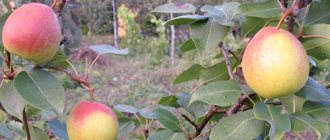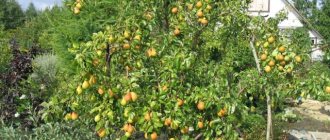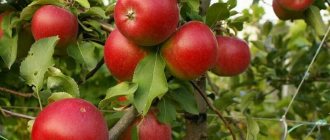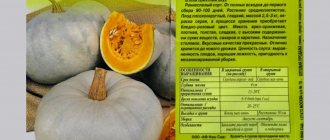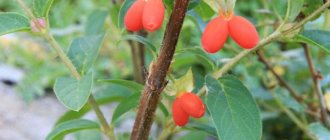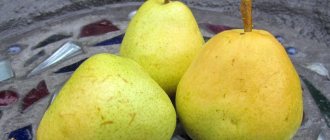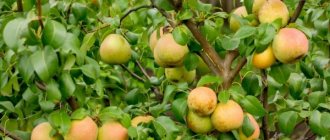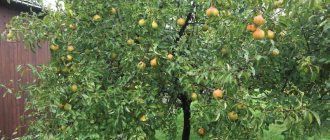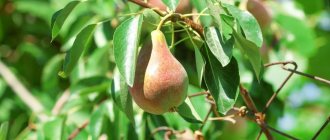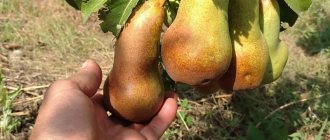Gardening » Pear
0
994
Article rating
Kira Stoletova
Despite the abundance of different fruit varieties, the Treasure pear is recognized throughout the world. This high-yielding variety begins bearing fruit in the fall, allowing you to enjoy tasty and healthy fruits all winter long.
Description of Treasure pear
Description of the variety
The Treasure Pear is named for a reason; there is a deep meaning here. A special feature of this pear variety is the size of the root system. Typically, a fruit tree’s root system is equal in area to the diameter of the crown; in a Treasure, the roots occupy an area 2.5 times larger than the crown size
Characteristics of wood
Treasure pear reaches a height of up to 2 meters, the crown is wide-pyramidal, medium thick. The main branches extend from the trunk almost at right angles, the ends pointing upward.
The trunk and branches are covered with flaky bark, dark gray in color, the shoots are smooth, the bark is olive-colored. The leaves are wide, ovate, with a pointed end.
Description of fruits
Pear Treasure.
The fruits are large, weighing 200-290 grams; there are specimens weighing 300 or even 500 grams. They are cone-shaped, slightly lumpy, the skin is dense, light green with a slight depression and a faintly noticeable orange blush.
When fully ripe, pears turn yellow. The pulp is white with a yellow tint, very juicy, oily, sweet with a piquant sourness.
Fruiting pear
The first flowering can be seen after a year, but there will be no fruit. The variety begins to bear fruit only in the fourth or fifth year after planting, since it is not a fast-bearing tree.
Regular fruiting of the Treasure pear begins 6–8 years after planting.
But trying the fruit itself, which is declared by agronomists, is possible only after 5–7 years . After this time, the pear tree bears fruit regularly and produces a fairly large harvest. some gardeners note that a pear can bloom twice in one season.
Ripening time
- The ripening period for this variety of fruit occurs in autumn
- Removable maturity occurs already in mid-September, while most of it remains on the branches, only a small part falls to the ground.
- At the beginning of October, consumer maturity occurs.
Productivity
The variety has high productivity, which is maintained every year.
The fruits ripen synchronously, hang tightly on the branches, almost without falling off.
On average, from one tree that is older than 10 years, you can remove 100 kilograms of fruit . At the same time, the yield may increase, depending on the method of caring for the pear.
Reviews
We bought a Treasure pear from a nursery and planted it in our dacha. Very pleased, the pears are tasty and large. They last until January, when we eat them fresh; we have compote in jars and jam in the basement.
Valentina
Cherry
In our area, the Treasure variety grows well and bears fruit. We don’t have any major frosts in the winter, but in the summer I water the tree and feed it in the spring and fall. The pears are very tasty, we eat them ourselves and treat our neighbors, there’s enough for everyone.
Vladimir
Light
There are three pear trees growing in our garden, and there is also a Treasure. The tree is not tall, everything is covered with pears. I use them to make compote, jam and pie filling for the winter. And what’s important is that it doesn’t get sick; one treatment in the spring is enough for prevention.
Olga
Raznochinovka
Pollinators and care
The variety needs a pollinator. Place nearby for these purposes Bere Mlievskaya, Williams, Dekanka de Comis, Conference, Klapp's Favorite or Plovdivskaya, which also bloom early.
The frost resistance of the form is sufficient for cultivation in the southern regions. The treasure can withstand winter temperatures down to -20°C without damage. Its resistance to diseases is much better - it is practically not damaged by scab, and is well resistant to pathogens of spotting, monilliosis, and bacterial cancer.
The variety cannot be classified as early-bearing - you will have to wait 5-7 years for magnificent pears after planting. As some gardeners note, a young tree blooms profusely, sometimes even repeatedly, and it can be strange not to see the same generous fruiting.
The southern origin of the plant is also reflected in the fact that it is quite sensitive to lower temperatures during flowering. A value of +15°C may be critical - below this figure, the fertilization process occurs intermittently.
In summer, pear trees need to be watered, especially in regions with hot climates. Under these conditions, drip irrigation appears to be the most economical. It is useful to occasionally sprinkle the crown to wash away dust from the leaves. This technique also works to prevent pest invasions.
Landing
Pears of this variety adapt well to different types of soil, but a correctly selected and prepared place will help the seedling to strengthen more quickly. Moreover, the root system of the pear is extremely developed and care must be taken to ensure that it has enough space. Useful materials on the topic of planting seedlings of the Treasure pear variety can be found in the articles selected below.
How to plant a pear tree correctly
At what distance to plant pears?
How to choose pear seedlings
How to replant a pear
Basic rules for growing varieties and agricultural technology
This variety loves the sun, so when choosing a location you should make sure that the tree will receive enough light.
There must be at least 3 meters of free space to the nearest trees or buildings.
There should not be any barriers or buildings at the planting site. This can prevent the tree from growing, and the rhizome can damage the foundation. Gardeners advise planting seedlings in loamy soil or chernozem; this is the ideal soil for a tree of this variety. But it is also worth paying attention that the presence of alkali or acid in the soil should not exceed 4 percent.
When the soil is unfavorable and it is impossible to plant in another place, you need to dig up and add lime to each square meter.
Landing
- To plant, you need to dig a hole of a certain size; gardeners recommend 50 by 80 centimeters.
When digging a hole, the fertile layer of soil is folded separately so that it can later be used to prepare a nutrient mixture.
After this, fertilizer is poured into it; for preparation you need to mix 10 liters of water, 30 mg of sodium nitrate and 20 mg of superphosphate.
The pit is filled with a fertile mixture and spilled with water.
After this procedure, it is possible to place the seedlings in the hole after two weeks.
A support stake is installed in the hole and the seedling is placed so that the root collar is at the level of the surrounding soil.
The rhizomes are sprinkled with earth and everything is watered abundantly with warm water, 20 liters per tree.
The planted pear is watered abundantly.
Pear pollination
This pear variety is not self-fertile. For this reason, in order to obtain a harvest, it requires natural sources of pollination.
The best pollinators for the Treasure pear will be the Conference or Lyubimitsa Kappa varieties.
To do this, plants are planted nearby and begin to bloom early. The following varieties are most often planted next to the Treasure:
- Decanque du Comis;
- Josephine Mechalska;
- Melting;
- Williams;
- Bere Mlievskaya;
- Motley July;
- Clapp's favorite;
- Conference.
Care
Trees of this variety do not require much attention. For a fruit crop, minimal care and standard agricultural technology will be sufficient. Recommendations for growing pears of the Sokrovische variety can be found by clicking on the links below.
How to care for a pear Pruning a pear Pruning a columnar pear Treating a pear from diseases and pests Feeding a pear How to water a pear
Care instructions
Pear is not picky
This variety requires standard care:
- Watering should be adjusted. It should be carried out once every 1.5-2 weeks. At this moment, 10-15 liters of warm water should be poured under each bush. It is better to irrigate the crop in the morning or evening so that the sun's rays do not evaporate moisture from the soil.
- Weed the area to remove weeds and loosen the top layer of soil to remove the crust.
- Fertilizing should be carried out for 2 years after planting in a permanent place. In the spring, at the end of March, a solution of phosphorus compounds should be added to the soil (50 g of superphosphate per 10 liters of water). At the beginning of fruiting, a solution of ammonium nitrate (20 g per 10 liters of water) is added. In the fall, after harvesting, a dense layer of humus should be laid around the main trunk of the tree, which will protect the plant from frost.
- Branches need to be trimmed in spring and autumn. In the spring, damaged and diseased branches are removed, which absorb many useful substances, which is why minimal fruiting occurs. In the fall, it is important to thin out the crown so that in the spring food reaches the inflorescences.
Read also: Make toys for decorative rabbits with your own hands
Diseases and pests
Treasure pear is resistant to scab, fruit rot, bacteriosis, powdery mildew and pest invasion. Spring preventative treatment is usually enough for the whole year.
Dangerous Pear Pests
Pears often suffer from pests, they affect the leaves, bark and fruits.
In this article, we have selected 11 of the most harmful insects that harm pear trees, and also ways to destroy them.
Diseases of pear trees
To get what they cherish, gardeners have to work hard, and the reason for this is pear diseases.
Read about 19 common pear diseases and how to combat them.
Advantages
Large beautiful fruits with a dessert sweet taste.
This variety has many advantages.
- The tree has beautiful and large fruits.
- Every year the yield is high, so not all fruit trees can boast of a regular and abundant harvest.
- The variety has a unique taste – dessert-sweet.
- The main advantage is its resistance to various diseases, as well as parasites, especially scab.
and disadvantages
A significant drawback is its lack of resistance to severe frost; for this reason, seedlings can only be planted in the southern part of the country.
It has been noticed that the taste of the Treasure pear greatly depends on the soil.
But also, not all gardeners are happy with the fact that the bush does not have a self-pollinating function. This requires planting other early flowering plants. And this causes certain troubles. In addition, this variety of pear requires certain soil characteristics, so it should not be planted in unfavorable soil and climatic conditions.
Pests and diseases
The description indicates that the Treasure pear species has an excellent immune system. The tree of this variety is not affected by powdery mildew, bacteriosis and fruit rot. The fruits are not affected by scab and codling moth.
The variety does not require treatment procedures. It is important to carry out preventive measures that will protect the bush from parasites. To do this, drip irrigation is used, which, falling on the leaves, washes away all bacteria and parasite larvae, even before the incubation period begins.
